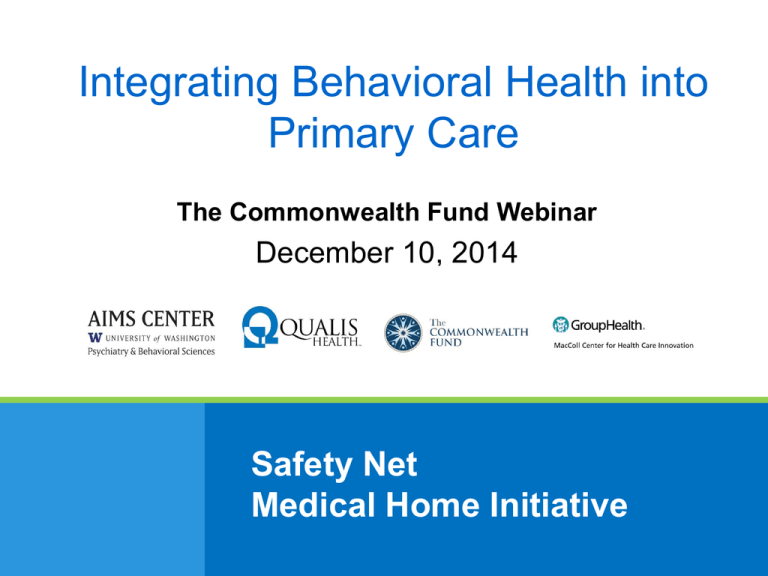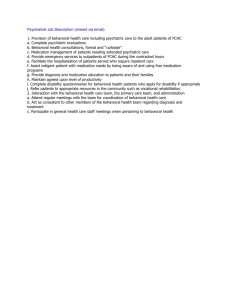Presenter slides
advertisement

Integrating Behavioral Health into Primary Care The Commonwealth Fund Webinar December 10, 2014 Safety Net Medical Home Initiative Integrated Behavioral Health Care in Safety Net Primary Care Clinics Jürgen Unützer, MD, MPH, MA Professor and Chair, Psychiatry & Behavioral Sciences Director, AIMS Center (Advancing Integrated Mental Health Solutions) University of Washington December 2014 WHO Definition of Health Health is a state of complete physical, mental and social well-being and not merely the absence of disease or infirmity (1948). The Challenge Behavioral Health Health Behaviors • Psychiatric disorders cause • 25% of all disability worldwide.(C. Murray, GBD Study, Lancet 2012) • 10% of Years Lived with Disability (YLD) from depression alone. • 3x diabetes,10x heart disease, 40x cancer • In the US, one suicide every 14 minutes. In WA, 2-3 suicides / day. • No family goes untouched. • Behavior determines ~ 50% of all mortality and morbidity. • Unhealthy behaviors are major drivers of health care costs. • 40% – 50% struggle with treatment adherence. • Employers struggle with absenteeism and presenteeism. How good is current care? • Fewer than 2/10 see a psychiatrist or psychologist. • 5/10 receive treatment in primary care • 2/3 of PCPs complain about poor access to mental health care for their patients • ~ 30 million receive an antidepressant Rx in primary care • BUT only 25% improve How do we close the gap? • Train more specialists? • Work harder? • Work smarter! = Integrated care. Leverage mental health specialists more effectively - partnerships (e.g., integrated with primary care) - technology (e.g., telemedicine) > 80 RCTs of collaborative care vs care as usual: collaborative care consistently more effective. (Archer et al, Cochrane Metaanalysis 2012). Integrated Care Primary Care Practice with PCP, Mental Health Care Manager, and designated Psychiatric Consultant Outcome Measures Treatment Protocols Population Registry Psychiatric Consultation Collaborative Care Doubles Effectiveness of Depression Care 50% or greater improvement in depression at 12 months Usual Care 70 IMPACT 60 50 % 40 30 20 10 0 1 2 3 4 5 6 7 Participating Organizations Unützer et al., JAMA 2002; Psych Clin NA 2004 8 JAMA, Dec 2002 Wall Street Journal, Sept 2013 IMPACT: Summary 1) Improved Outcomes: • • • • Less depression Less physical pain Better functioning Higher quality of life 2) Greater patient and provider satisfaction 3) More cost-effective THE TRIPLE AIM “I got my life back” Taking effective models to scale Bridging the Implementation Gap • Implementation guide supplement, "Organized, EvidenceBased Care: Behavioral Health Integration" • General outline: o The Case for Behavioral Health Integration o Integrated Behavioral Health Care: What it is and How it Works o Implementing Integrated Behavioral Health Care o Monitoring Progress o Building Integrated Care Teams o Leveraging Success: Spreading and Sustaining SNMHI 11 Two Cultures, One Patient SNMHI 13 Andrea R Fox MD Chief Medical Officer Squirrel Hill Health Center Squirrel Hill Health Center Squirrel Hill Health Center Behavioral Health Services Behavioral Health Team • • • • • • • • • • • Psychiatry LCSW/ Therapist Primary care providers/dental staff Care navigator RNs Front office staff Medical assistants OB/GYN Americorp members Administrative staff ACA counselor – – – – – – HRSA Grant Increase psychiatry from 20% to 50% Increase LCSW from 50% to 100% Coordinator for fast intervention and tracking Front office staff 2 FTE peers 6 hour psychologist Martin Abdo, Certified Peer Specialist and Peer Bridger, Harborview Medical Center, Seattle Washington SNMHI 22 www.safetynetmedicalhome.org SNMHI 23






